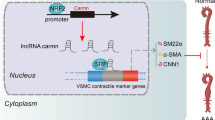Abstract
Oxidized low-density lipoprotein (ox-LDL), one of the most important risk factors of atherosclerosis, is a highly antigenic, potent chemoattractant that facilitates the development of atherosclerosis. Gap junctions also play an important in the development of atherosclerosis. In this study, we investigated the effects of ox-LDL on connexin43 and the mechanisms of connexin43 siRNA-inhibited apoptosis induced by ox-LDL in human umbilical vein endothelial cell (HUVEC), to clarify the role of connexin43 in atherosclerosis. Our results showed that ox-LDL significantly inhibited the growth and promoted apoptosis of HUVEC in a dose-dependent manner. Also, ox-LDL upregulated the expression of connexin43. Furthermore, knockdown connexin43 by siRNA promoted proliferation and inhibited apoptosis in ox-LDL-stimulated HUVEC. Moreover, the level of phosphor-ERK1/2 and connexin43 was remarkably attenuated by a ERK pathway inhibitor (PD98059). These results suggest that connexin43 siRNA promotes HUVEC proliferation and inhibits apoptosis induced by ox-LDL, and ERK signaling pathway appears to be involved in these processes.





Similar content being viewed by others
Abbreviations
- PTCA:
-
Percutaneous transluminal coronary angioplasty
- Ox-LDL:
-
Oxidized low-density lipoprotein
- HUVEC:
-
Human umbilical vein endothelial cell
References
Libby P, DiCarli M, Weissleder R (2010) The vascular biology of atherosclerosis and imaging targets. J Nucl Med 51:33S–37S
Chen LJ, Lim SH, Yeh YT et al (2012) Roles of microRNAs in atherosclerosis and restenosis. J Biomed Sci 19:79–90
Bernat R, Szavits-Nossan J, Trbovic A et al (2012) Relationship of genetic markers for atherosclerosis and long-term outcome after percutaneous coronary intervention with stenting. Coll Antropol 36:1385–1390
Kozak O, Tariq N, Suri MFK et al (2011) High risk of recurrent ischemic events among patients with deferred intracranial angioplasty and stent placement for symptomatic intracranial atherosclerosis. Neurosurgery 69:334–343
Adiguzel E, Ahmad PJ, Franco C et al (2009) Collagens in the progression and complications of atherosclerosis. Vas Med 14:73–89
Corbi G, Bianco A, Turchiarelli V et al (2013) Potential mechanisms linking atherosclerosis and increased cardiovascular risk in COPD: focus on sirtuins. Int J Mol Sci 14:12696–12713
Roy A, Kolattukudy PE (2012) Monocyte chemotactic protein-induced protein (MCPIP) promotes inflammatory angiogenesis via sequential induction of oxidative stress, endoplasmic reticulum stress and autophagy. Cell Signal 24:2123–2131
Vanhoutte PM (2009) Endothelial dysfunction: the first step toward coronary arteriosclerosis. Circ J 73:595–601
Grover-Páez F, Zavalza-Gómez AB (2009) Endothelial dysfunction and cardiovascular risk factors. Diabetes Res Clin 84:1–10
Yang H, Mohamed ASS, Zhou SH (2012) Oxidized low density lipoprotein, stem cells, and atherosclerosis. Lipids Health Dis 11:85–92
Morel S, Burnier L, Kwak BR (2009) Connexins participate in the initiation and progression of atherosclerosis. Semin Immunopathol 31:49–61
Ruan LM, Cai W, Chen JZ et al (2010) Effects of Losartan on expression of connexins at the early stage of atherosclerosis in rabbits. Int J Med Sci 7:82–90
Cai W, Ruan LM, Wang YN et al (2006) Effects of angiotensin II on connexin 43 of VSMCs in arteriosclerosis. J Zhejiang Univ Sci 7:648–653
Kwak BR, Mulhaupt F, Veillard N et al (2002) Altered pattern of vascular connexin expression in atherosclerotic plaques. Arterioscl Throm Vas 22:225–230
Chadjichristos CE, Scheckenbach KEL, van Veen TAB et al (2010) Endothelial-specific deletion of connexin40 promotes atherosclerosis by increasing CD73-dependent leukocyte adhesion. Circulation 121:123–131
Chen LJ, Lim SH, Yeh YT et al (2012) Roles of microRNAs in atherosclerosis and restenosis. J Biomed Sci 9:79–90
Zhang Y, Li L, You J et al (2013) Effect of 7-Difluoromethyl-5, 4′-dimethoxygenistein on aorta atherosclerosis in hyperlipidemia ApoE−/− mice induced by a cholesterol-rich diet. Drug Des Dev Ther 7:233–242
Zhang X, Li H, Jin H et al (2000) Effects of homocysteine on endothelial nitric oxide production. Am J Physiol-Renal 279:F671–F678
Gimbrone MA, Topper JN, Nagel T et al (2000) Endothelial dysfunction, hemodynamic forces, and atherogenesisa. Ann N Y Acad Sci 902:230–240
Riwanto M, Rohrer L, Roschitzki B et al (2013) Altered activation of endothelial anti-and proapoptotic pathways by high-density lipoprotein from patients with coronary artery diseaseclinical perspective role of high-density lipoprotein-proteome remodeling. Circulation 127:891–904
Krysko D, Leybaert L, Vandenabeele P et al (2005) Gap junctions and the propagation of cell survival and cell death signals. Apoptosis 10:459–469
Wei CJ, Xu X, Lo CW (2004) Connexins and cell signaling in development and disease. Annu Rev Cell Dev Biol 20:811–838
Rodríguez-Sinovas A, Cabestrero A, López D et al (2007) The modulatory effects of connexin 43 on cell death/survival beyond cell coupling. Prog Biophys Mol Bio 94:219–232
Zhang S, Hong M, Gao Y (2012) Effect of oxidized LDL on the expression of connexins in cultured human umbilical-vein endothelial cells. Cell Biol Int 36:497–502
Plotkin L, Bellido T (2001) Bisphosphonate-induced, hemichannel-mediated, anti-apoptosis through the Src/ERK pathway: a gap junction-independent action of connexin43. Cell Commun Adhes 8:377–382
Dimmeler S, Zeiher AM (2000) Endothelial cell apoptosis in angiogenesis and vessel regression. Circ Res 87:434–439
Disclosures
None.
Author information
Authors and Affiliations
Corresponding author
Additional information
Guotian Yin and Xiuli Yang contributed equally to this work and are considered co-first authors.
Rights and permissions
About this article
Cite this article
Yin, G., Yang, X., Li, B. et al. Connexin43 siRNA promotes HUVEC proliferation and inhibits apoptosis induced by ox-LDL: an involvement of ERK signaling pathway. Mol Cell Biochem 394, 101–107 (2014). https://doi.org/10.1007/s11010-014-2085-4
Received:
Accepted:
Published:
Issue Date:
DOI: https://doi.org/10.1007/s11010-014-2085-4




